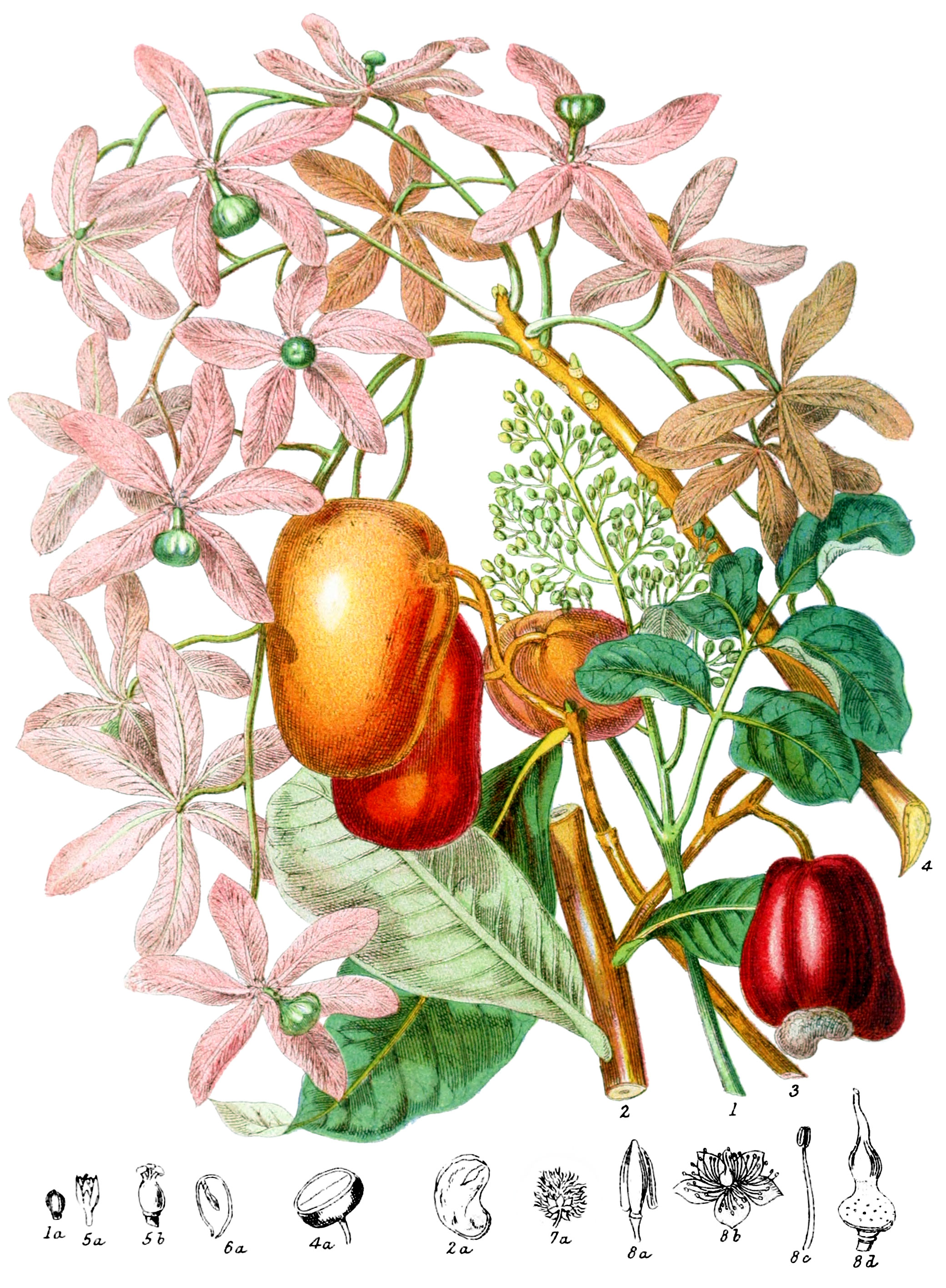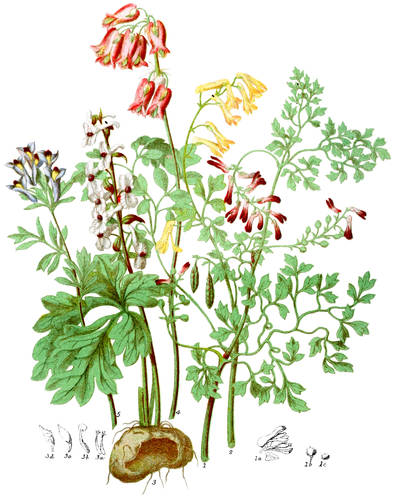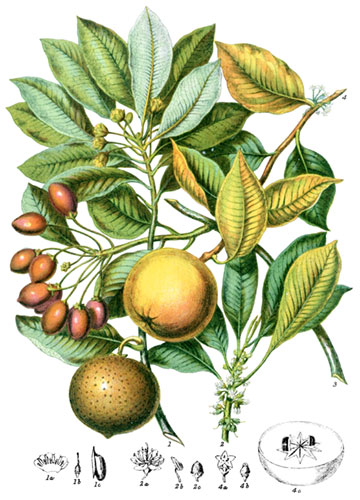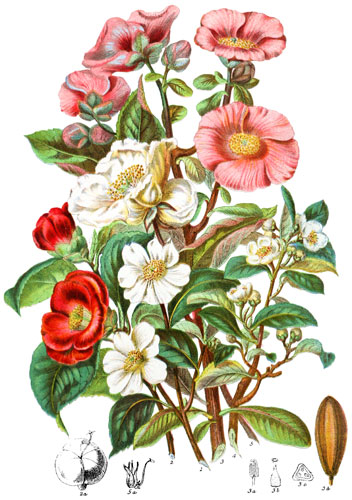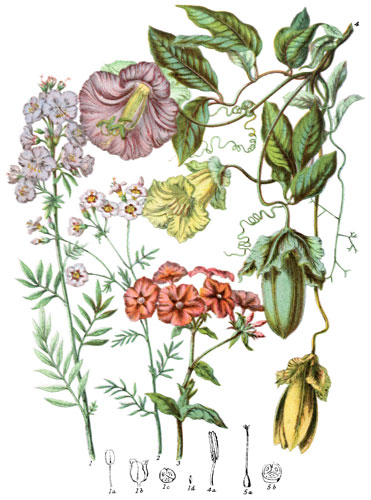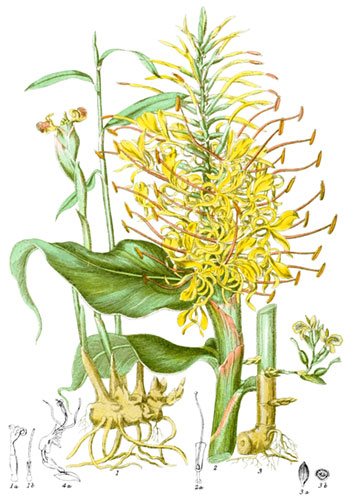Key characteristics
Trees and shrubs abounding with resionous gummy sap, or a milky caustic juice; the leaves are alternate, simple or compoudn, without stipules, and having no pellucid dots. The flowers either at the ends of the branches or from the base of the leaf-stalk. The stamens and pistil are seldom perfect in the same flower; the calyx is usually small and persistent, with five or seven divisions; sometimes the sepals are united, and it falls off. The petals are equal in number to the segments of the calyx, attached to its fleshy disk, occasionally wanting. The stamens are equal in number to the petals and alternate with them, growing separately from the disk, or cohering at their base when the disk is absent. The ovary is generally one-celled, having an ovule attached to its base by a cord; it is surmounted by one style, or three or four, as many stigmas. The fruit is most commonly a drupe; the seed contains no albumen.
This Tribe has some affinity with the Walnut tribe, although the flowers are disposed differently.
A resinous, acrid, and extremely poisonous juice prevails in these plants.
Select plants in this order
Not all plants listed are illustrated and not all plants illustrated are listed.
- Pistacia Terebinthus (1) is the tree which yields the celebrated Cypress Turpentine, a limpid balsamic resin, remarkable for its fragrance. Incisions being made in the bark, the turpentine exudes during the night, and is collected in the morning before sunrise; the produce is extremely small, consequently it is very costly, and it is liable to be mixed with other turpentine.
- P. Lentiscus affords the more abundant Mastick, which, flowing from transverse wounds made in the trunc, concretes on the ground, and is gathered up for use; it was formerly much employed as a medicine, and is still esteeemed by the Turks and Armenians.
- P. atlantica yields the same kind of resin.
- The fruit of P. vera is the eatable Pistacia-nut, once much used in cookery, but now of little value.
- Anacardium occidentale (2) is a curious example of an apparent fruit formed by an enlarged fleshy stalk. The name was given on account of the heart-shape of the nut which is attached to the end, and remains without exterior covering. Between the shell and the kernel there is a thick caustic oil, blistering the skin if incautiously touched: the natives use it for preserving wood from decay; the fresh kernels are of delicious flavour when young; in an older state, they are generally roasted, and mixed with cocoa, make an excellent chocolate. The pulpy part, or apple, has an agreeable acid taste, and is easten in the West Indies either fresh or roasted; the juice is fermented for wine, or distilled for a spirit. From the stem a milky liquid is obtained, which marks linen with an indelible black; also a fine semi-transparent gum exudes from the bark.
- Spondias, a Greek name for Plum, is applied to a genus bearing eatable fruit called Hog-plums in the West Indies; the thin yellow pulp covering the large fibrous stone has a sweet scent and not unpleasant flavour. Cuttings of these plants grow so readily, that in St. Domingo hedges made of them take root and produce flowers and fruit in the course of a few months.
- S. dulcis is cultivated in the islands of the Pacific Ocean for the sake of fruit, and is known as the Otaheite Apple.
- Mangifera (3), or Mango, the native name, is a large spreading tree, producing one of the most esteemed fruits of the East. In this country, we know it only in a green state, pickled. When fully ripe, the soft pulp is filled with an agreeable and wholesome juice; the fruit as well as the shell within is of a kidney shape; in size and quality, it varies as much as the European apple. Among the drawings of the late Mr. Longcroft, alsready alluded to, a Mango Grove, near Lahore, gives a noble idea of these majestic trees.
- Melanorrhœa (4) is described by Dr. Wallich as one of the most valuable trees of the East, forming, together with Teak and Saul, extensive forests. The stem attains thirty or forty feet before branching; it contains throughout a thick viscid grey juice, which on exposure to the air changes to black; one tree yields about 12lbs. in the year. This abundant and cheap varnish is employed either pure or coloured for all kinds of boats, and for vessels to contain anything liquid or solid; it is besides much used by the Burmese in gilding their idols, and for religious writings on ivory. The points of the calyx remaining united, it falls off, after which the petals expand and enlarge considerably; as the seed ripens, they acquire a brown colour.
- Semecarpus and other genera yield also a valuable varnish in Silhet and China.
- Schinus is a very graceful shrub, with slender pinnated leaves, growing near the shore in Teneriffe, and on the Andes at an elevation of 8000 feet.
- Rhus is most known in Europe as the Sumach, an alteration of its Arabic name.
- R. vernix is the Japanese varnish with which almost everything is located in Japan.
Locations
The Tropics are the chief station of the Tribe. Pistacia in habits the south of Europe and the Levant. Rhus is most extensively dispersed, being found in Northern India, in South Africa, in North America, and south of Europe. Duvaua and Schinus belong to Chile; no species have yet been discovered in Australia.
Legend
- Pistacia Terebinthus, Turpentine Tree. South Europe.
- Seed.
- Anacardium occidentale, Cashew Nut. West Indies.
- Section of Seed.
- Mangifera indica, Mango Tree. East Indies.
- Melanorrhœa usitata, Varnish Tree. Martaban.
- Section of Fruit.
-
- Pistacia atlantica. Pistil flower.
- Ovary and Pistil.
-
- Pistacia vera. Section of Seed.
-
- Rhus lasiocarpa. Fruit.
-
- Melanorrhœa glabra. Calyx.
- Flower.
- Stamen.
- Ovary and Pistil.
Explore more
Posters
Decorate your walls with colorful detailed posters based on Elizabeth Twining’s beautiful two-volume set from 1868.
Puzzles
Challenge yourself or someone else to assemble a puzzle of all 160 botanical illustrations.
